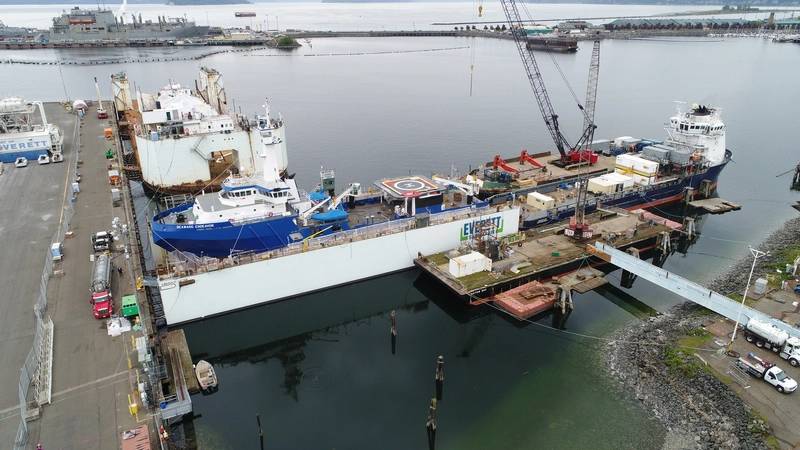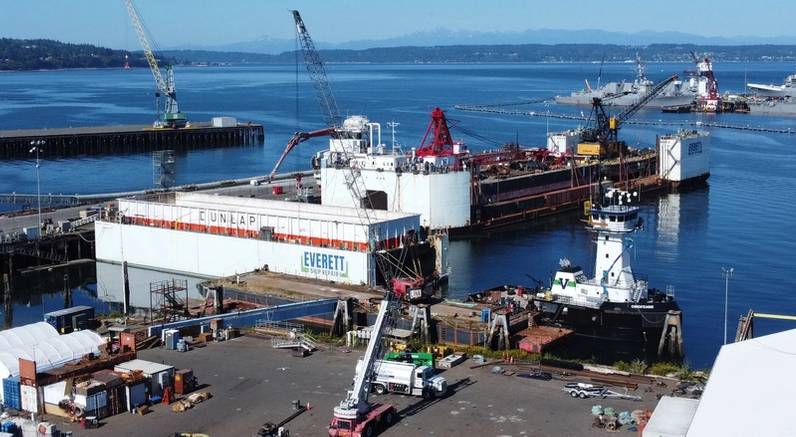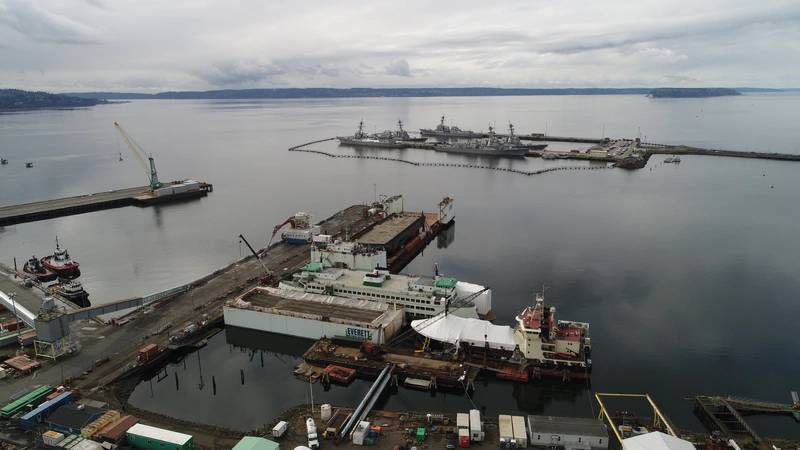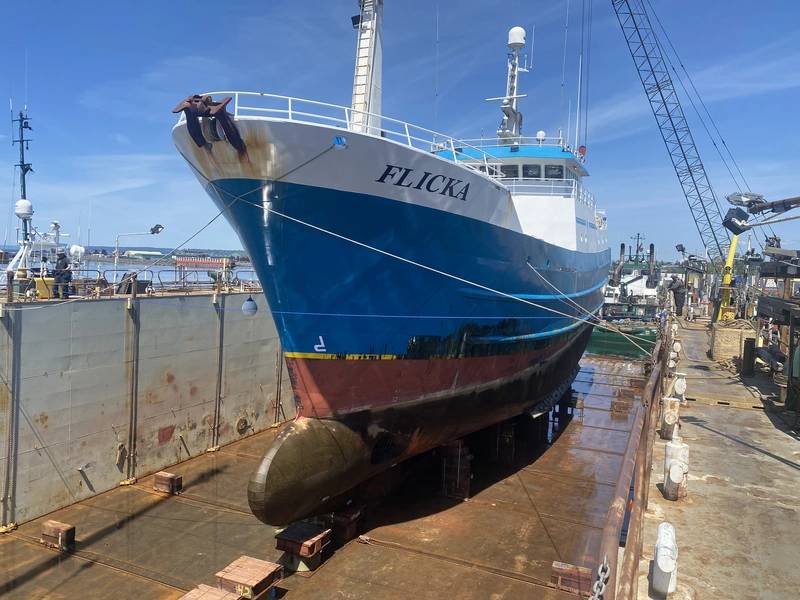Interview: Lane Richards, Everett Ship Repair
Lane Richards has worked in the maritime industry for 22 years. He began his career in the trades prior to a successful transition to project management and various sales management roles.
After a short but successful stint at Nichols Brothers Boat Builders, Richards transitioned to head up the commercial sales effort at Puglia Engineering’s Fairhaven Shipyard prior to returning to Nichols Brothers in 2019. There he began work with their team in planning and subsequently standing up a dedicated repair yard on the Everett waterfront. Presently he is focused on business development and strategic growth initiatives for both Nichols Brothers and Everett Ship Repair as VP of Service Sales.
What motivated you to pursue a career in the maritime industry?
My dad built boats for just shy of 50 years, and I grew up down the road from the yard where he spent the first 38 of those years. The comradery and work ethic at that place were strong.
I remember any time our dog went missing I’d go down to the yard and find her wandering around looking for him. For the most part, the yard crew knew me (and my dog) and if anyone saw me hanging out at the gate they’d send the dog up. I was in grade school with a lot of the other guys’ kids, and whether I was on summer break taking my dad lunch, or running around one of the new boats that had just been launched with a bunch of other shipyard kids during a christening party, it just felt like a big family.
Shortly after high school I went to work for a supplier in the industry, and after about 12 years with that company I got an opportunity to work for a shipyard. I’ve loved this industry from an early age, and in my opinion, the future is bright for anyone willing to put the work in.
 (Photo: Everett Ship Repair)
(Photo: Everett Ship Repair)
How has Everett Ship Repair evolved and expanded its operations since opening in 2019? Will you please give an overview of its current facilities, equipment and capabilities?
ESR started out with a dry dock, its dockmaster and a handful of folks and borrowed equipment from sister company, Nichols Brothers. As we close in on five years of operations, we’re 120+ heads strong with two dry docks, a fully outfitted yard and an expanding footprint within the Port of Everett. The previous tenant that operated a yard only had about 500 feet of waterfront and three or four acres of uplands. When we leased the site, the existing footprint was not sufficient as our dry dock was too large to operate where the previous dock sat, so the port included the north side of Pier 3 as part of our footprint. Today we have access to the south side of Pier 3 (800 feet long with deep water) as well as the 900 feet of waterfront at the port’s newly minted Norton Terminal for in-water service work.
Thanks to the award of a few small shipyard grants and investment from our ownership, we have brand new air compressors, UHP Waterjets, rolling stock and crane capacity, along with every shop and associated equipment you’d expect to find in a repair yard. Our large drydock is 436 feet (loa) by 110 feet in between the walls and is rated at about 8,000 tons lifting capacity. The smaller dock is 220 feet (loa) by 62 feet between the walls and about 2,000 tons of lift.
 (Photo: Everett Ship Repair)
(Photo: Everett Ship Repair)
How is the company investing—in technology, facilities, people, etc.—to ensure future success?
We are currently looking at robots that work with our blasting equipment to improve production rates and increase safety in surface prep, automated welding equipment and exploring laser ablation. Additionally, we just commissioned a few new machines in our machine shop and are looking at green energy initiatives like broad power monitoring for identify opportunities to reduce carbon footprint in our operations.
However, the biggest investments that we have been making for the past couple of years are in our people and processes. For a young yard that has grown fast, there is plenty of low hanging fruit in this area. Simply put, it is smart, hard-working people that are all rowing in the same direction, to the same drumbeat that are going to take us to the next level. We were recently lucky to have hired a new general manager, Jon Shaton. Jon is a Navy veteran and has worked in commercial and government ship repair and new construction on every U.S. coast. His last stop was building frigates on the Great Lakes and he possess all of the tools and knowhow to guide the yard in the direction we need to go. We have a talented group of project managers, admin support, production management and crafts people that continue to up their game as we grow. The apprenticeship program we run in concert with our sister yard, NBBB, feeds us a steady stream of young, hungry up-and-comers.
Our recently approved Master Ship Repair Agreement (MSRA) with the U.S. Navy, which governs process and facility standards, coupled with our various workforce development initiatives has us positioned well to continue and expand on a path of rapid growth.
How much of Everett Ship Repair’s workload is commercial vs government projects, and how does this balance shift? Where do you see greatest opportunity going forward?
In the first couple years of operation, we had to continually remind ourselves to “walk before we run”. But as we rounded our second year in business, the complexity of work began to ramp up along with our capabilities. While we are still probably heavier on commercial work, we just had an MSC ship on our pier for in-water service and currently have a Navy Caisson in dock. We’d like to see a bit more government work in the yard, but our commercial customers have always been and will continue to be critical to our business. We are confident that we can succeed in this balanced approach, and we have a plan for executing this mix with eyes wide open to the importance of how we segregate these business lines.
In the short term, we see opportunities to support both commercial and government customers with the addition of deepwater pier space as well as remote work at Naval Station Everett. We are watching NSE’s growth closely and believe that our proximity to the base and strong value proposition rooted in commercial ship repair positions us well to support the government as the number of ships grows there in the coming years.
 (Photo: Everett Ship Repair)
(Photo: Everett Ship Repair)
How are recent technological advancements impacting the ship repair industry? Are advances in areas such as digitalization and automation, for example, having any impact?
While ship service, repair and major conversions have always and will always rely on skilled trades people, digitalization and technological advancements certainly provide advantages. As front-end planning has evolved from physical templates and drafting tables to CAD and 3D scans of existing structures, the improvements in a shipyard’s ability to detail out every aspect of a job has advanced by leaps and bounds. If you fail to plan, you plan to fail.
Out on the dock floors, our trades people are learning to run robotics, and by doing so, are reducing injuries and improving quality and efficiencies.
Yes, there has been positive impacts from technological advancements, but I believe the advantages in higher value to our customers, quality of life for our trades people and the shipyards bottom line are only going to increase in the coming years and decades.
What are the biggest challenges currently facing the Everett Ship Repair, or even the ship repair industry in general, and what is the company doing to address these challenges?
For most businesses employing blue collar trades, ship repair included, the biggest challenge is finding the people willing to do the work. We address this issue in many ways, but namely through engaging with the numerous workforce development organizations in the Puget Sound area, our own in-house apprenticeship program, paying competitive wages and generally providing an environment which enables rapid upward mobility to employees in a positive, forward thinking and operating environment.
 (Photo: Everett Ship Repair)
(Photo: Everett Ship Repair)
As ESG continues to grain greater focus across all industries, what steps is Everett Ship Repair taking to promote sustainability and reduce environmental impact?
As the youngest shipyard on the US West Coast, regulated by the stringent Washington State Department of Ecology along with the latest regulations administered by federal EPA/Clean Air we are likely one of the cleanest yards on the waterfront. Regulators will, over time, get some of the older legacy yards/permit holders up to snuff, but we have, from day one, been set up to meet a higher bar regarding ESG when compared to our competitors.
Can you share a recent success story or project that exemplifies your company’s capabilities?
While I do not comment on specific customers or vessel names, it always feels good to deliver projects early and under budget. We recently did this on a complex project for a large fishing vessel owner as well as an early delivery for a major ferry operator with a pressing need to get their vessel back in service.







